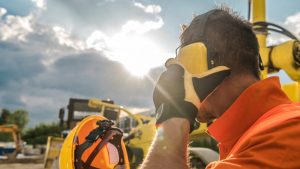Cases of work-related non-melanoma skin cancer among construction workers in Ontario are on track to double by 2060 unless additional protective measures are taken, according to new research done by the Institute for Work & Health (IWH).
If protective equipment and clothing such as long-sleeve shirts, pants and neck coverings are worn by construction workers, however, up to 6,034 cases of such cancers could be averted over the next three decades. That would result in $38 million in costs (in 2017 Canadian dollars) being saved over a 30-year period.
The figures were revealed in a cost-benefit study done by Dr. Amir Mofidi, a post-doctoral fellow at the IWH, and Dr. Emile Tompa, a senior scientist at the institute, who developed an economic analysis methodology.
The research also found that providing the use of shade structures alone, such as portable canopies or pop-up tents that are near jobsites for workers to use whenever they need during a work shift, could also result in fewer cases. As many as 2,945 cases in Ontario could be averted over 30 years, resulting in savings of $20.5 million, if shade structures were used.
The study was published online recently in the Journal of Occupational and Environmental Hygiene.
“Non-melanoma skin cancer from occupational exposure in the construction sector can be prevented by simple solar UVR preventive measures such as wearing protective clothing and using shade structures,” explained Mofidi.
The study is a follow-up to an earlier analysis in which the researchers estimated the economic burden of occupational and non-melanoma skin cancer across Canada. The new research builds on those findings to estimate the cost-benefit of using protective measures that are available to most workplaces.
The researchers evaluated the costs and benefits of solar ultraviolet radiation (UVR) exposure prevention strategies implemented in the Ontario construction sector over a 30-year time period from 2030-2060.
Mofidi said the intent of the study is to inform decision-making about the value of promoting good practices for the prevention of solar UVR exposure in the sector.
“The benefits that are expected to be realized by averting each case of non-melanoma skin cancer, is something that we estimated in our previous economic burden study which was published in 2018.”
The new analysis found that, in a scenario where protective clothing is worn by workers and its use offers 100 per cent protection from 2020 onward, the yearly costs and benefits of this intervention would even out by 2046. A similar scenario for shade structures would see yearly costs and benefits even out by 2041.
Where partial compliance with the measures results in only 60-per-cent protection, the break-even dates would be 2051 for protective clothing and 2044 for shade structures.
“Given the latency of non-melanoma skin cancer, it takes a while for the cases averted and related costs averted to increase to a level comparable to the intervention costs,” he noted.
“For the construction industry, simple measures such as providing proper sun protective clothing and constructing temporary shade structures on jobsites could reduce UVR exposure and the incidence of non-melanoma skin cancer.”
Those measures include coverings for the neck, ears, eyes, forehead, nose and scalp, he said.
“In our previous study, we reported that non-melanoma skin cancers are one of the most common types of skin cancers in Canada, which annually impose a large economic burden on society.”
Tompa noted Carcinogen Exposure Canada estimated the largest occupation group exposed to UVR is workers in the construction sector, followed by workers in farming, and workers in services to buildings and dwellings.
While the facts are clear, a question becomes how to convince construction workers to don protective clothing and take precautions.
“Researchers around the world, and particularly in Australia and the European Union, have found that enhancing people’s awareness of simple prevention measures through sun safety promotion/sensitization campaigns is an effective way to reduce UVR exposure and sunburns,” said Tompa. “Both bear on subsequent cases of non-melanoma skin cancer.”
According to Mofidi, shade structures are most often preferred over protective clothing. But in the case of construction, workers in some occupations – such as those working at heights – are less likely to be able to use them.
He noted the costs and benefits of work-related cancer-prevention interventions are unevenly distributed.
“The costs are borne primarily by employers, while the savings resulting from averted cancer cases are realized by the health-care system, and by workers and their families in the form of averted health treatment costs, caregiving costs, loss of income and loss of health-related quality of life.
“It would be good to have stakeholders negotiate an acceptable distribution of prevention costs, as the total benefits substantially outweigh the total costs.”





Recent Comments